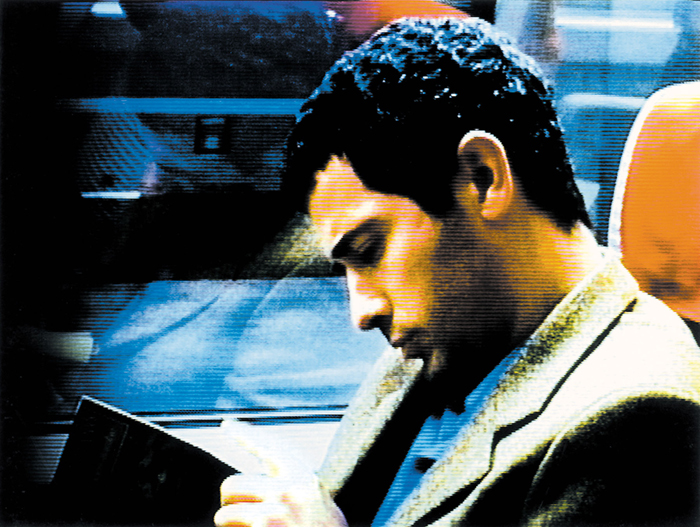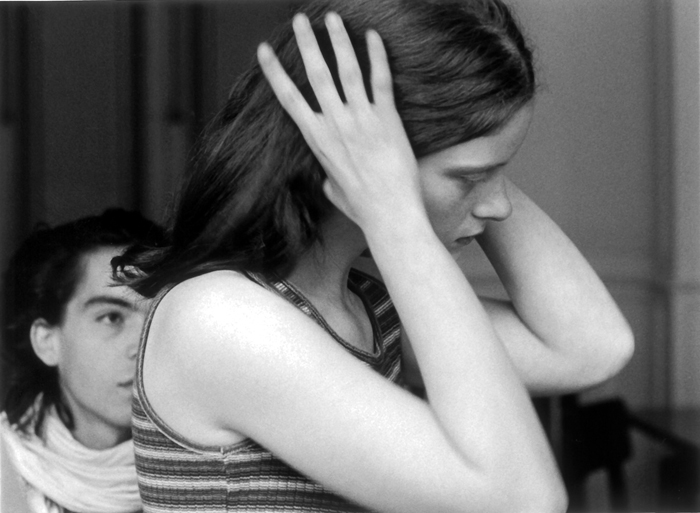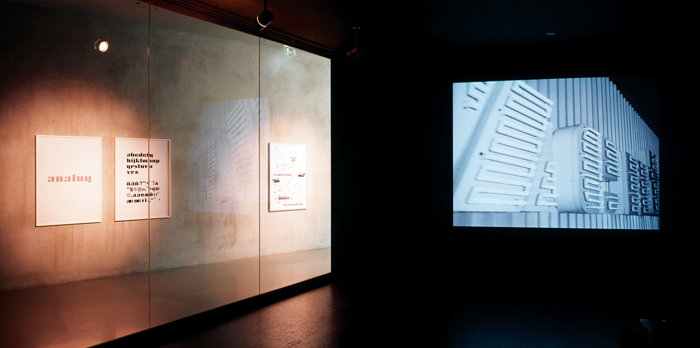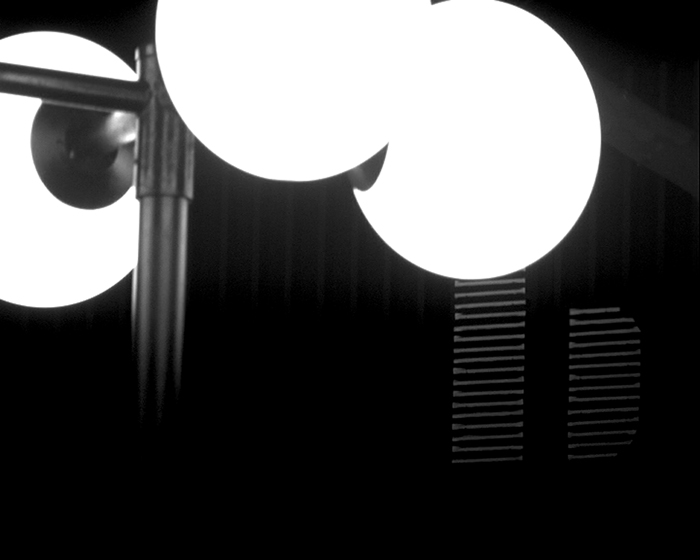The figure refers, not to what the human solitude of the amorous subject may be, but to his “philosophical” solitude, love-as-passion being accounted for today by no major system of thought (of discourse)… If it should occur to me to knock at the…doors [of Christian, Psychoanalytic, or Marxist discourse] in order to gain recognition somewhere for my “madness,” these doors close one after the other; and when they are all shut, there rises around me a wall of language which oppresses and repulses me–unless I repent and agree to “get rid of x.”
—Roland Barthes1We have to multiply poetic subjects and objects—which are now unfortunately so rare that the slightest ones take on an exaggerated emotional importance.
—Guy Debord2
On Love and Science
For a branch of historical Conceptualism–one influenced by logical empiricism–the subject of Eros in the context of analysis is so out of place that the mere inference of the personal induced allergic reactions. Take, for instance, Daniel Buren’s canonical text, “Beware!” in which he offers a series of warnings describing how a conceptual practice could misfire into personal folly.3 Subjectivity, in the guise of the anecdote, is at the top of his list. “Under the pretext of concept the anecdotal is going to flourish,” Buren warns, “… [and this] is a way for the artist to display his talents as conjurer. In a way, the vague concept of the word ‘concept’ itself implies a return to Romanticism.” That would be Romanticism with a capital “R,” referring to the 18th Century movement from which Barthes culled his primary literary reference—Johann Wolfgang Goethe’s 1774 novel The Sorrows of Young Werther—for his book A Lover’s Discourse. Celebrating the individual’s emotional encounter with the sublime, historical romanticism was polemically positioned against the rationalist Enlightenment. This is what makes Barthes’s appropriation of Werther so perverse after his well-known structuralist analyses of cultural myths associated with late capitalism. So why did he do it? And why are a key number of younger political artists today, ones trained on the rationalist conventions of structuralist film, photo-documentary, and conceptualist systems analysis, following suit?
It is essential that Barthes’s perverse act of romanticism be understood not as a dialectical reversal of his prior Marxist position but as a continuation of that analysis, albeit one radicalized by Lacanian psychoanalysis. Specifically, A Lover’s Discourse was informed by the lessons of Lacan’s Seminar XI (1964), in which the question of the analyst’s desire, or counter-transference, became central following Lacan’s “excommunication” from the traditionalist International Psychoanalytic Association for unconventional (i.e. “unscientific”) clinical techniques. The IPA viewed the analyst’s desire as a stain in the field of analysis, as something to be cleaned up. But in their attempt to clean it up, by refusing to renew Lacan’s membership in the name of Science with a capital “S,” Lacan’s transgressive technique was subsequently encoded as a political, anti-authoritarian act. In scientific terms, an analyst’s qualifications are based upon his/her adherence to a set of procedural conventions ratified through peer review. In the case of broader cultural analysis, to which Barthes’s early structuralist writings belong, critical distance in the service of cognitive mapping was the established convention for the (cultural) analyst’s qualifications. If A Lover’s Discourse was thus seen by the Marxists as a stain in the field of cultural analysis, it was because–following Lacan–it employed the tactic of complicit and lyrical self-referentiality.
Structuralism’s critical distance was central to a group of international artists working in the 1960s–Dan Graham, Victor Burgin, Hans Haacke, Bernar Venet, and Stephen Willats prominent among them. Through “systems analysis,” the act of simply denoting a fact or procedure, these artists employed scientific convention in defiance against Greenberg’s Kantian aesthetics and the more general subjectivism of high modernist painting. But there was a holdout against critical distance among the conceptualists. I am speaking of Mary Kelly’s Post-Partum Document, a project that documented the artist’s son’s acquisition of language, which, in turn, launched a psychoanalytic branch of Conceptualism.
At every turn in Post-Partum Document we see something placed where it should not be, most notably the quotidian systemic analysis of a daily event (the infant feeding charts) printed upon dirty diapers, followed by the artist-as-mother’s question “what have I done wrong?” This juxtaposition, qualified analysis on the one hand, critical self-doubt on the other, underscored what was entirely repressed from orthodox Conceptualism–the question of the critic’s subjectivity, or longing, in the space of analysis. This erotic “stain,” literalized in Post-Partum Document by the child’s fecal matter, affords a psychoanalytic reading of love, the same one put forth in A Lover’s Discourse. Although this reading of love has only recently found its way into contemporary art practice, it’s been the main concern of Jean-Luc Godard’s films over the last 30 years. And it is through Godard that we see how historical consciousness poetically and critically dovetails with the question of Eros.

On Love and History
What Lacan said at the end of Seminar XI is relevant here: “When, in love, I solicit a look, what is profoundly unsatisfying and always missing is that…you never look at me from the place from which I see you. Conversely, what I look at is never what I wish to see.”4 In love, there is thus the problem of an untraversable divide, a state which the historian analogously faces vis-a-vis his object of desire in the form of a “lost” past event. As Lacan said, on the matter of the subject’s never being able to complete himself romantically by way of truly coalescing with the Other, there is no sexual relation. The same may be extended, allegorically, to the historian and his event when we say: there is no historical relation. Godard’s theory of love and history, the subject of his film In Praise of Love (2001), directly relates to this Lacanian paradox.
Edgar, the film’s protagonist (and Godard’s alter-ego), is an intellectual trying to make a film about three couples representing three generations: young, adult and elderly. Each of these love stories is further comprised of four stages (in love as in history): meeting, passion, separation and reconciliation. In the three couples’ lives, and in the film Edgar is making about them, these four moments always arrive either too early or too late for the subjects–what Freud called “deferred action”–producing a crisis of historical agency for the film actors and their real-life referents. To invoke this crisis in the love story one needs to collapse the operation of historical time onto the narrative arc of love. Edgar warns his young actress: it is not Eglantine’s story, but a story of history moving through her…it is the moment of “youth.” At the other end of the generational spectrum, Edgar follows the older couple, both Resistance survivors, in the process of selling their story to a Hollywood film director. The couple’s historical moment is one lived before the story that will be sold to Hollywood, and, paradoxically, one that will be lived by others (and by them, both newly and again) only after its Hollywood re-presentation. Caught in the middle, finally, Edgar tries unsuccessfully to be an “adult”–to experience the political presence of 1968, the event whereby 10 million students, workers and intellectuals waged a general strike in France, seeking a better way of life in the wake of their overthrown Vichy government. This moment of adulthood occurs between the moments of youth (Eglantine) and old age (Resistance survivors). But adulthood, like the historical event itself, is a very slippery, fleeting object because the adult is neither in the primordial moment of youth (pure experience) nor in the elderly space of reflection (pure representation).

Godard’s crisis of historical, linear time—the non-differentiation of “befores” and “afters”—is essential to the poetics of his critique. It forms the narrative arc of his film and is explicitly political and autobiographical. The first part, filmed in Godard’s signature ’60s black and white, is the narrative’s “present.” The second part, recorded on video in color, is the narrative’s “past.” This order—past after present–is the way we come to know history: a story of beginnings only after the end. But what of the skipped space between—the so-called “adult” space? For Godard, that’s the space of critical, historical self-reflexivity, though it’s also the space most often skipped over or derailed by the historian or critic. Why is this allegorical adulthood skipped over? The answer entails the very question of how to be present in love/politics, if the definition of being “present,” in Aristotelian terms, entails “being” outside historical time. The question becomes even more complicated when we employ Freud’s notion of time whereby we are only “present” in/through the contemporary re-enactment of a past moment. For example, in Godard’s film the Holocaust exists simultaneously “before” 1968 (the moment of real trauma) and “after” 1968 (the moment of the trauma’s representation). In Alain Badiou’s terms, the truth of this (or any event) really comes “to be” in a subsequent moment of artistic production/reception. The question for the artist thus arises: how can we work within a moment of “adulthood” (for Godard/Edgar it is the failed moment of 1968—for us it might be 2001), if this moment arrives always too soon or too late for us to act as present in any conventional sense? Moreover, how do we work within this space of endless divisibility—one that the historian represses in the service of linear time–without getting lost, without losing the critical agency (or presence) at which we aim? In Lacanian terms, if there is no historical relation, how do we relate to the presence of our past?

Indeed it is possible to work within this paradoxical space, but it necessarily entails getting something wrong in conventional historical terms. It entails framing the process of historical agency as it repeatedly comes together and falls apart through time. For Godard this type of temporal crisis described the very process of the French Resistance’s legacy–how the movement only ever experienced a childhood (before) and an old age (after), but never a present “adulthood.” In other words, the Resistance should have reached its presence in the subsequent ’60s cultural revolution. But it didn’t because 1968 never succeeded the way the resistance did. The film’s premise is that this imagined space of “adulthood,” a metaphor for the event of May 1968 when materialist change coupled with the aesthetic avant-garde had a chance, is something at which Edgar (and the rest of us) can only aim in the form of critique, though we can never fully re-occupy it in any revolutionary sense. Hence Godard’s poetic recourse to lover’s discourse in his film. In politics, as in love, there is always the moment of meeting, passion and separation, but ultimate reconciliation between people/history is fleeting. And yet this fleeting moment is the moment that analysis and longing come together in the form of a poetic critique. Simply, this continual missed encounter, what the historian or scientist represses, is what remains.
If Godard, like Barthes before him, takes a poetic approach to art and politics after the so-called failure of 1968, it isn’t a nostalgic, sentimental pose. Rather, it’s a necessary position when materialist historical conditions refuse to advance. Fast forward to the late ’70s. In his afterword to the anthology Aesthetics and Politics: The Key Texts of the Classic Debate within German Marxism, Fredric Jameson comments that “routine torture and the institutionalization of counter-insurgency techniques have proved perfectly consistent with the kind of parliamentary democracy that used to be distinguished from fascism. Under the hegemony of the multinational corporations and their world system, the very possibility of a progressive bourgeois culture is problematic.” 5 That was written in 1977—the same year Barthes published A Lover’s Discourse–but it could have been written in 2008. Certainly, as Bertolt Brecht once argued, as reality changes so do the means necessary to “represent” it in art. But what happens when the same political events–the failure of Europe in 1933 or the failure of the student movement in 1968—continue to return even though the aesthetic debates of those events have withered? We go to work again on modernist aesthetic debates over reality and representation, with the caveat that such debates now entail the recognition that history is always already coupled with the historian’s desire, and memory coupled with his or her repression.
Such going to work describes a group of artists—Dorit Margreiter, Florian Pumhoesl, Mathias Poledna, Kerry Tribe, Sharon Hayes, Ken Gonzales-Day, Andrea Geyer, and Katya Sander—whose “history-based” projects can be thought of as Conceptualism after Lacan. Intervening in the contemporary cultural landscape, one in which historical consciousness is either fading away or mythologically reconstructed in the hands of political pundits and governmental figures, these artists “document” our desirous relation to a given historical and aesthetic event. In their hands we can no more return to the event than we can readily dismiss it, just as Goethe’s sorrowful young Werther could neither obtain nor dismiss his beloved Lotte. This isn’t because the artists don’t know their history. Nor is it because they are sentimental romantics. Rather, they reject any empirical, didactic attempt to grasp an historical event in the space of aesthetic experience. Instead, they induce a crisis of historical consciousness, one based upon the disorienting recognition of how memory paradoxically operates upon our psyches as being at once “there” and “not there.”
Standing in front of these artists’ work my mind begins to wander. I am confronted with the work of historical memory in place of being given any specific memory to own. In this moment I fail to recall something–an historical event, an aesthetic movement, a political revolution–that, in turn, refuses to recede into the past. I realize that I am gleaning the crisis of an a-temporal moment of critical reflection, one in which past, present and future fold back onto one another, and I begin to feel Modernism’s project wash over me as much as I know Modernism’s project is long gone. This is the temporal crisis of the so-called “punctum” about which Barthes so famously wrote but which is still so curiously misunderstood.6 I am interested in this work. Here is a case study of one of them.

The Poetics of Critique
Just as Mary Kelly’s Post-Partum Document took on the position of the analyst only to reveal a repressed desire, Margreiter’s zentrum (2005) takes on the position of the archivist to reveal the contradictions of cultural memory. The accurate retrieval of cultural memory is the archivist’s raison d’etre. What’s at stake is the fear of losing the recollection of some thing or event. And yet, restoring an historical record paradoxically and necessarily entails effacing the original event in the process of the archivist’s written work of accurate retrieval. zentrum, a project that “documents” the reconstruction of a lost modernist logotype, speaks directly to this paradox.
In 2006 the artist set out to reconstruct a neon sign—”Bruehlzentrum”—affixed to the facade of a socialist residential building in Leipzig, an act that she and her crew would film.7 Margreiter’s return was staged at a specific historical moment. The building and sign were decrepit relics of the modernist aesthetic strategies used by the GDR in the ’60s to support their socio-political ideals. At the time of her “reconstruction,” the residential building, like so many architectural remnants of the GDR, was scheduled for demolition to make way for the current government’s neo-1930s urban plan for Leipzig’s city center. In this context, the year of Margreiter’s filming, “2006,” functioned as a temporal pivot between “1960”—when the building was constructed—and “1930” the moment to which Bruehlzentrum would return. Again, it is a case of pasts before presents, the reconciliation of which is fleeting.
zentrum’s material base further plays out this Godardian paradox, for the work at once documents an event and is a film about documentation. In its installation at Galerie fuer Zeitgenoessische Kunst, zentrum had two forms. In video format, zentrum documents the actual reconstruction of the original sign. In 16mm format zentrum is a 2 minute 30 second black and white film loop, cropped as a close frame to feature the reconstructed logotype. On the one hand, the color video follows the visual cues of standard documentary television–the camera pans the site of reconstruction at a distance allowing the viewer to comprehend the event in context of the mise-en-scene Margreiter has given us. On the other hand, the film abstracts the reconstruction process to “celebrate” the lighting of the logotype alone, resulting in images reminiscent of the Constructivist experiments in typography a century before.
We should note, however, that Margreiter’s “reconstruction” of Bruehlzentrum isn’t a restoration of the neon tubes themselves, which would have entailed patching the glass tubing and reinserting inert gases so that the tubing would glow when activated by a high voltage. Instead, Margreiter affixed reflective tape onto the neon tube’s exterior. The sign was then “lit up” by the reflected glow of the lights used to make the film itself. This meant that the sign was turned on through the process of its own filmic representation from the outside, even though the effect at first glance is that the tubes are being illuminated from the inside. If the viewer watches closely, he or she will see that Margreiter has purposely captured the camera’s lighting device on film to expose the real causal relationship between the camera and sign I’ve described here. In a poetic way, the reconstructed sign thus enacts the Lacanian paradox of the subject, one in which the subject’s perceived Innenwelt (interior psyche) is always already activated by his or her Umwelt (exterior reality).8 In fact it is between these two states that we, as subjects, attempt to be present. As such, zentrum metaphorically demonstrates that there is no historical “thing-in-itself” apart from representation. Rather, as with the archive, it is the very act of representation that enacts the event of a given subject’s coming to be (inasmuch as representation effaces the subject’s authenticity).
That said, why the use of analog film? In 1936, Walter Benjamin famously argued that of all the art forms film held a privileged relationship to socialist revolutions because it was a serial medium. This, ostensibly, unpacked the myth of singularity or individual “aura” associated with the dictatorships rising throughout Europe. In today’s context of digital technology, we tend to reinvest film with aura because it, like that branch of utopian Modernism that Bruehlzentrum recalls, is an increasingly outmoded practice. As today’s art programs and photo labs increasingly replace “wet” analog processes with “dry” digital ones, the very concept of film as a medium–how it literally works–is slipping from cultural consciousness.9 In this context, the attempt to reconstruct and memorialize what’s soon to be excised from history as a failed aesthetic (i.e., avant-garde architecture, design and filmmaking) has resonance. Indeed there is a palpable longing that encodes zentrum, in-as-much as there’s an urgency for the artist to capture something before it goes–an urgency not unlike Gordon Matta-Clark’s attempt to split a house in half and film it before the demolition crew arrives.

But again, this performative longing should not be confused with nostalgia. Nor should it be seen as an attempt to redeem modernist aesthetics in general or filmmaking in specific. Rather, zentrum presents us with a series of mediated or deferred encounters with “the real thing.” For instance, the representation of the completed sign was shot first in digital and then transferred to 16mm film. This, in effect, reverses the chronology of events should digital technology connote the present and analog film the past. When Margreiter’s crew is “on site” with Bruehlzentrum (the historical moment now gone) she shoots in contemporary color digital. When she/we are “on site” with the subsequent artwork (the contemporary moment here now) she projects Bruehlzentrum’s image in the outmoded medium of black and white film. As In Praise of Love demonstrated, this is the way we come to know history: pasts as presents or a story of beginnings only after the end. If Margreiter thus solicits a crisis of being in relation to historical repetition, she does so knowing full well that we can never step into the same river twice because historical repetition is the return of that which only appears to be self-identical–the mythological notion that I am once again in that space in time. In reality an historical moment can only evoke, in the work of art, what Lacan called the objet a (the impossible object), a tangible moment at which we continue to aim and will always necessarily miss. But as I have said of Godard’s project, a different mode of critique can be found within this act of aiming, a gesture that holds historical positivism and historical amnesia in suspension. This is the work of poetic critique.
Juli Carson is Associate Professor in the Studio Art Department at UCI where she teaches Critical and Curatorial Practice in Contemporary Art and directs the University Art Gallery. She is also editor of Exile of the Imaginary: Politics, Aesthetics, Love (Koeln: Walter Koenig Press, 2008). Her forthcoming book, The Conceptual Unconscious, will be published by Les Figues Press.
